
- Home
- India
- World
- Premium
- THE FEDERAL SPECIAL
- Analysis
- States
- Perspective
- Videos
- Sports
- Education
- Entertainment
- Elections
- Features
- Health
- Business
- Series
- In memoriam: Sheikh Mujibur Rahman
- Bishnoi's Men
- NEET TANGLE
- Economy Series
- Earth Day
- Kashmir’s Frozen Turbulence
- India@75
- The legend of Ramjanmabhoomi
- Liberalisation@30
- How to tame a dragon
- Celebrating biodiversity
- Farm Matters
- 50 days of solitude
- Bringing Migrants Home
- Budget 2020
- Jharkhand Votes
- The Federal Investigates
- The Federal Impact
- Vanishing Sand
- Gandhi @ 150
- Andhra Today
- Field report
- Operation Gulmarg
- Pandemic @1 Mn in India
- The Federal Year-End
- The Zero Year
- Science
- Brand studio
- Newsletter
- Elections 2024
- Events
- Home
- IndiaIndia
- World
- Analysis
- StatesStates
- PerspectivePerspective
- VideosVideos
- Sports
- Education
- Entertainment
- ElectionsElections
- Features
- Health
- BusinessBusiness
- Premium
- Loading...
Premium - Events
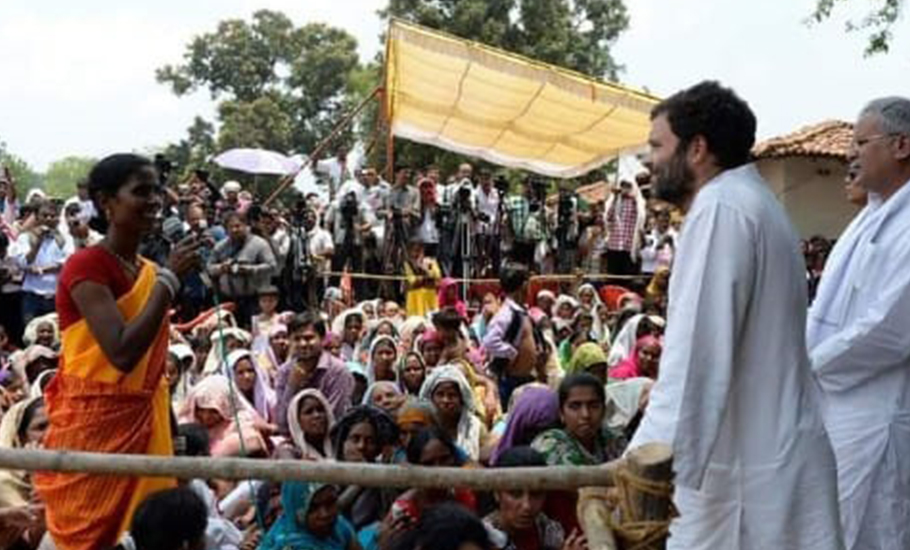
You don’t have our consent for mining: Hasdeo Aranya adivasis tell govt

On October 28, the Chhattisgarh Tourism Board laid out the red carpet in Raipur for artists belonging to diverse tribal communities from the state as well as various countries for a three-day dance gala. The National Tribal Dance Festival, Chief Minister Bhupesh Baghel said, will promote and “celebrate” the uniqueness of tribal culture and showcase the “richness and diversity” of...
On October 28, the Chhattisgarh Tourism Board laid out the red carpet in Raipur for artists belonging to diverse tribal communities from the state as well as various countries for a three-day dance gala.
The National Tribal Dance Festival, Chief Minister Bhupesh Baghel said, will promote and “celebrate” the uniqueness of tribal culture and showcase the “richness and diversity” of tribal life of Chhattisgarh and other states to the world.
Meanwhile, fifteen members of one such indigenous tribe, which “contributes to the vibrant culture” of Baghel’s state, are camping in Delhi after being “betrayed” by the chief minister.
The “betrayal”, they say, came even after 250 adivasi villagers from the dense Hasdeo Aranya forests walked a full 300 km to Baghel in Raipur and received an assurance that the state will not give clearance to mining in the Parsa coal block in Chhattisgarh.
On October 21, the Union government accorded stage II clearance for mining in the Parsa coal block in Chhattisgarh. Parsa is one of the six coal blocks allocated in the region despite adivasi resistance.
What has hit these villagers hard is that the Union government in its letter has said that the state government has given a green signal for the project.
The letter from the Union government says:
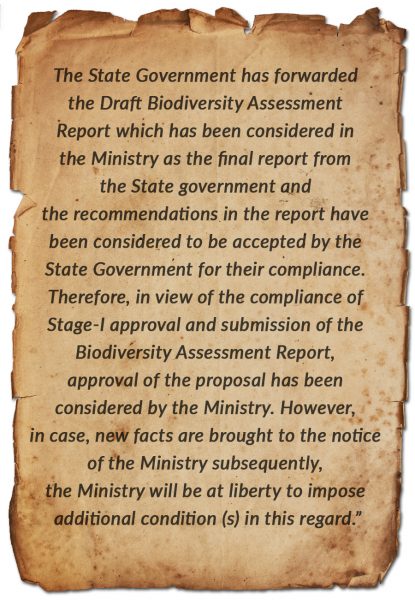
The resistance
Thirteen years after he first refused to make way for a proposed coal mine project in Hasdeo Aranya forest in Chhattisgarh, Jainandan Porte, 45, is up in arms yet again to protect his land and forest around him.
Porte is a resident of Ghatbarra village, which borders the Parsa East and Kente Basin (PEKB) Coal Block owned by Parsa Kente Collieries Limited, a subsidiary of Adani Mining Private Limited, in the Hasdeo Aranya forest region.
On October 3, Porte along with nearly 250 other tribals from about 35 villages, under the banner of Hasdeo Aranya Bachao Sangharsh Samiti, undertook a nearly 300-km padyatra (march on foot) to make their voice heard in Raipur.
The tribals demanded the cancellation of all coal mining projects in the region and highlighted that the permissions were granted illegally without their consent. The tribals alleged that the gram sabha approvals for land acquisition were forged and the government never consulted them. Most of the tribals in these regions are forest dwellers, agriculturists and farm labourers.
Ironically, the protest is going on at a time global leaders are flying to Scotland’s port city Glasgow to deliberate for nearly over a fortnight on how to save the planet from climate change and environmental degradation.

People like Porte may not have any clue about such big summits, but the concerns that the tribals are raising go beyond just losing land. They are also worried about the environmental cost of the mining project which environmentalists say will destroy the ecology of the region.
The Hasdeo Aranya protest comes in the midst of news of a coal crisis in the country that the Union government termed as baseless.
The protesting villagers, who started their journey on October 3, took 11 days to reach Raipur on foot. On October 13 and 14, they met governor Anusuiya Uikey and CM Baghel and returned after receiving an assurance of a probe into the ‘forged’ approval of gram sabhas for coal mining in the forests.
On October 21, the adivasis came in for a shock when they learnt that the Union Environment Ministry gave the second stage approval for coal mining in the Parsa block with conditions for compensatory afforestation and other norms, based on the recommendations of the state government. Interestingly, the first stage approval has to come from the state government.
State’s clarification
Trying to wash its hands off, the state government issued a contradicting statement soon after the Union Ministry’s approval. Chhattisgarh Forest Minister Mohammad Akbar said neither his ministry nor the state government took any step after stage one approval, which came in February. He also said they have not given any consent for the opening of coal blocks.
In February, the state government gave its nod for diverting 841.538 hectares of forest land for non-forest purposes under the Forest Conservation Act 1980, for the proposed Parsa Open Cast Mine (5MTPA) in favour of Rajasthan Rajya Vidyut Utpadan Nigam Ltd (RRVUNL), in Surguja and Surajpur districts of Chhattisgarh.
The Parsa East-Kente Basan block was awarded to RRVUNL, a state-run organisation, in 2007. Adani Enterprises bagged the contract from RRVUNL to mine in the region. The block holds reserves of over 450 million tonnes of coal estimated to produce 15 million tonnes a year.
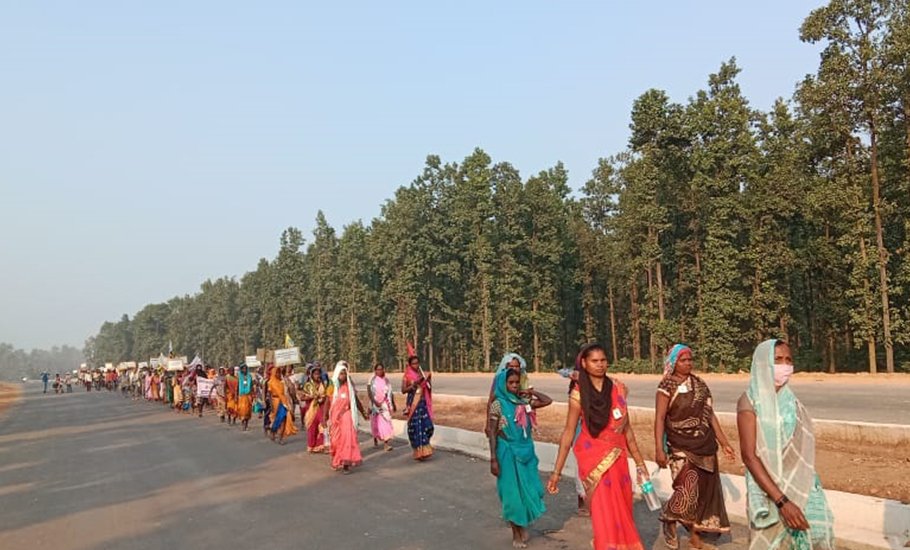
Porte and other villagers say they feel betrayed. “We are fighting for our survival. They promised that they are with us and won’t let the mining activities happen. But soon after we returned, they turned their back on us,” Porte says.
In Delhi
Refusing to relent, Porte and 14 other villagers are in Delhi with a hope to knock at the doors of Congress leader Rahul Gandhi to remind him of his promise. In 2015, on a visit to Hasdeo, Gandhi had assured the tribals of his support for ensuring the region remains off-limits for mining activity.
In 2011, the Congress-led UPA government had given the nod for the first coal blocks in Hasdeo Aranya.
The protesters are seeking a revocation of environment and forest clearances for mining in the Parsa coal block. They want a ban on mining work in areas where the consent of gram sabhas has not been taken apart from FIR and action against the company and officials for “forging” gram sabha consent.
Their other demands include implementation of “free, informed and prior consent” from gram sabhas for land acquisition and allocation of contracts for mining or any other commercial activity in areas under Schedule 5. The protesters are also seeking implementation of all provisions of PESA Act 1996, a law which was enacted to provide self-governance through traditional gram sabhas in Scheduled Areas of India.
It’s long road ahead
Porte, who belongs to the Gond tribe, is a graduate. He’s a second-generation farmer. Porte cultivates vegetables, paddy and maize on five acres of forest land that his family has been holding for more than four decades now. He is the sole earning member in a family of eight and has five school-going children in the house.
“The Prime Minister promotes Aatmanirbhar Bharat. We are the ones who are truly aatmanirbhar (self-reliant). We self-sustain and protect nature and don’t depend on any government services,” he says. “But now, we are facing pressure from all sides — government, administration, police and mining companies, to part with our land and forest.”
Before commencing their journey on October 3, Porte and others had planned to cover 30-50 km a day and sought permission from villagers en route to halt and rest for the night. They carried food, medical essentials and a change of clothes.
Ramlal Kariyam, who is a senior leader of the Sangharsh Samiti and belongs to the Gond community, is a worried man. “How can we leave the ancestral village where our deity has been established? It is difficult even to think that we will be rehabilitated somewhere,” he said.
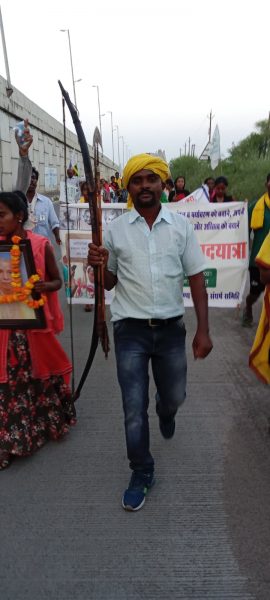
Thirty-three-year-old Karyiam holds a master’s degree in arts. “We grew up in forest land and we want to protect this. What will the animals and birds do if they destroy this forest,” he asks.
Kariyam, whose land is located in Salhi village of Parsa coal block area, said the company officials are playing every kind of gimmick and are enticing the innocent tribals to acquire their land.
Kariyam says the 300-km journey wasn’t much of a pain compared to the injustice being meted out to the community. “Some developed fever, some got leg pain, and some fell unconscious. But we overcame it and reached our destination,” he says.
He says the government did not follow procedures while seeking consent from the gram sabha. Kariyam alleges that outsiders were brought in to show a meeting was held and they had agreed to give up their land.
“We have been fighting for over a decade now. The government has to initiate a probe. We will not part with our land come what may.”
The protests notwithstanding, Kariyam says, the government is moving ahead with taking over land for mining.
“Land acquisition for Parsa is underway despite opposition from Gram Sabhas, multiple complaints to CM, Ministry of Tribal Affairs and other authorities, legal cases challenging environment and forest clearances on grounds of multiple irregularities,” he adds.
According to Kariyam, if the government disregards their voices, they too will disregard government documents and approvals and fight till their last breath.
Asked about the compensation being offered, Kariyam says even though compensation [under regulations of the Right to Fair Compensation and Transparency in Land Acquisition, Rehabilitation and Resettlement Act, 2013 and Chhattisgarh Ideal Resettlement policy 2007] will be paid, it would not be enough. “We will be evicted and left homeless.”
On June 15, 2020, sarpanchs (village heads) of nine villages in the Hasdeo Aranya region wrote to Prime Minister Narendra Modi opposing the auction of coal mines. They called on Modi to stop the auctioning and sought to stop mining in the region.
Environmental cost
A total of 23 coal depositories have been identified in the Hasdeo Aranya region for mining and seven have already been allocated. While two of them are operational, the rest are awaiting clearances from state and Union governments.
The Hasdeo Aranya is a forest region in the Surguja and Korba districts of northern Chhattisgarh and is one of the largest intact dense forest patches in central India spread across 170,000 hectares.
It is rich in biodiversity with over 450 species of flora and fauna, including critically endangered species such as elephants, leopards and sloth bears. There is a significant elephant presence in the area throughout the year as the region is part of a large migratory corridor.
The catchment of Hasdeo, Mahanadi’s largest tributary, irrigates over 3 lakh hectares of double-cropped land in Surguja and Korba districts in the Hasdeo Aranya area of the mineral-rich Chhattisgarh state. Agriculture and minor forest produce are the main sources of livelihood for the tribals.
Most of the land in the region comes under Schedule 5 and is home to around 20,000 tribals and forest dwellers. The Fifth Schedule deals with the administration of scheduled areas where tribal communities are in a majority. Rules say tribal advisory councils (TACs) should be constituted to deal with the welfare and advancement of scheduled tribes in states.
Environmentalist and tribal right activist Alok Shukla is of the view that the threat of irreparable loss of Hasdeo Aranya is now imminent and needs urgent action.
“Consequences of losing Hasdeo Aranya will be disastrous, not just locally but nationally,” he says.
On one hand, he adds, there will be loss of one of the most beautiful forests and ecologically important regions of India. On the other, it will result in an uncontrolled increase in human-wildlife conflict across Chhattisgarh, he adds.
Land acquisition will also be a threat to the Bango reservoir and three lakh hectares of irrigated agricultural land. Unforeseen impact on the hydrology of Hasdeo-Mahanadi system can lead to devastating ecological and livelihood consequences (fisheries, agriculture, water scarcity), according to Shukla.
“More importantly, it will be irreparable damage to the life, livelihood and identity of tribals of northern Chhattisgarh.”
Mining work is going on in Parsa and East Kete Basen (PEKB) projects despite the fact that the National Green Tribunal (NGT) in 2014 cancelled the forest clearance. With the case pending in the Supreme Court, work in ongoing by way of a stay order.
Recently, the Indian Council of Forestry Research and Education (ICFRE) & Wildlife Institute of India (WII) report highlighted the adverse impacts of mining which include loss of forest cover, increased human-elephant conflict, geo-morphological as well as hydrological changes and drainage restrictions, apart from widespread displacement.
The Environment Ministry in 2015 noted that the Supreme Court has not stayed the complete order of the NGT but only Part 4 whereby the mining operation was suspended.
The case was then referred to the Forest Advisory Committee on NGT’s directions and the Minister of State for Ministry of Environment, Forest and Climate Change.
Subsequently, the BJP government auctioned several coal blocks located in Hasdeo. In 2020, five coal blocks were withdrawn from auctions by the central government based on state government intervention. Even then, pre-mining activities continue in five other adjacent coal blocks.
The tribals say that even after multiple policy revisions, majority of Hasdeo Aranya region is deemed ‘inviolate’ but new mines are being opened in violation of the policy.
Changing stance
Prior to 2011, the Ministry of Environment and Forests had on at least three occasions rejected coal mining projects citing the pristine and unfragmented forest belt in the area.
In 2002, the Wildlife Trust of India (WTI) conducted a study and suggested setting up an elephant reserve considering the wildlife movement in the region. The idea was scuttled under pressure from the mining lobby.
Successive state governments failed to notify the area as a reserve even as the Centre granted in-principle approval. The project’s boundaries have now been modified to exclude all coal-bearing areas. According to the Union government’s notification, 452 square kilometres of Hasdeo Aranya has been reserved for the elephant project.
Although an official communication said the government had increased the area and announced reserving 1,995 square kilometres for Lemru Elephant Project, it will protect only the forests of Korba region. The restriction would not be there for mining work in the Surguja region of the Hasdeo Aranya area.
Environmentalists say the government is now circumventing the need for “gram sabha consent” by arguing that consent is not required under Coal Bearing Areas Act and thus issued notification for land acquisition for Madanpur South and Gidhmudi Paturiya even before any clearances or consultations.
The Gidhmuri Paturiya block has been allocated to Chhattisgarh State Power Generation Company Limited, with Adani Group as mine developer and operator (MDO). And Madanpur South block has been allocated to Andhra Pradesh Mineral Development Corporation, with Aditya Birla Group as MDO, and here too land acquisition is underway.
The RRVUNL and the Adani Group, however, didn’t respond to emails sent by The Federal in this regard.
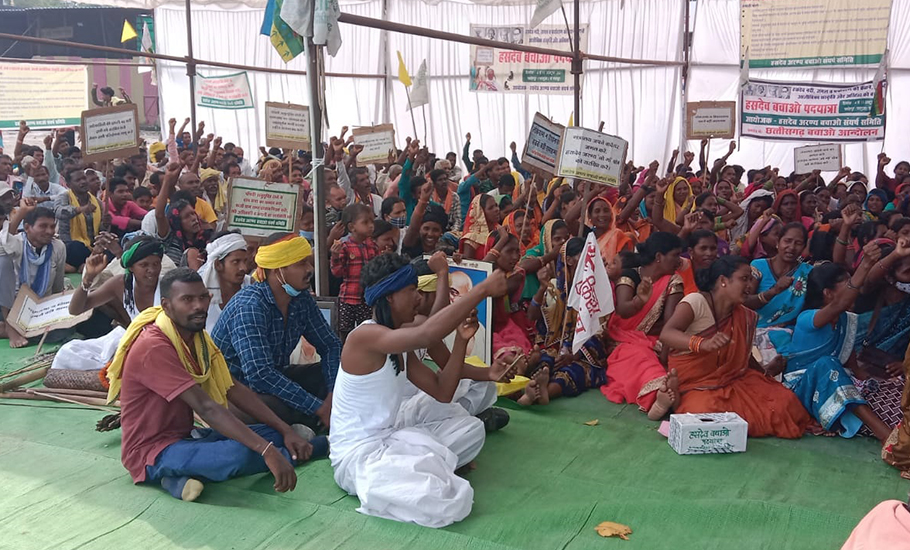
Even as Raipur cheers villagers dancing to folk songs and congratulates itself for preserving tribal culture, people like Kariyam don’t know how they should remind those in power of their promises.
“The ruling Congress party in Chhattisgarh seems to have gone back on its promises made by Rahul Gandhi, Bhupesh Baghel and other senior leaders before Assembly elections,” Kariyam says.
(Abhijat Shukla is a Chhattisgarh-based journalist)
